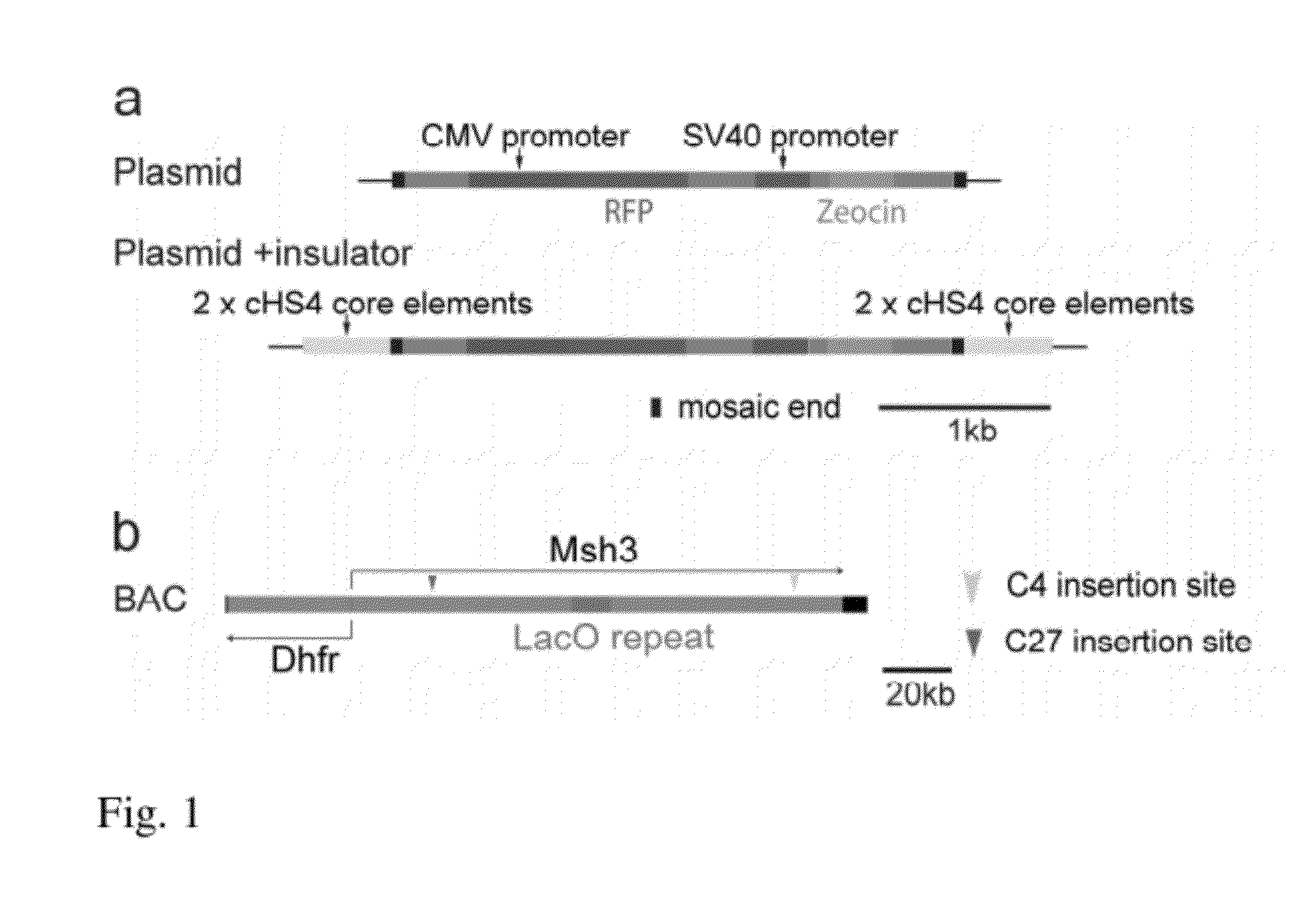Recombinant Gene Expression
- Summary
- Abstract
- Description
- Claims
- Application Information
AI Technical Summary
Benefits of technology
Problems solved by technology
Method used
Image
Examples
example 1
Copy Number Dependent, Position Independent Expression of a mRFP Reporter Gene Inserted at Two Different Locations into a BAC Containing the DHFR Gene Locus
[0097]We inserted a mRFP reporter gene at two different locations within a 170 kb BAC containing the DHFR locus (Bian and Belmont 2010) (FIG. 1). The DHFR BAC used contains the DHFR gene locus and part of the Msh3 gene locus. Both are transcribed from a divergent promoter located between the two genes. We used a Tn5 transposon system to randomly insert the mRFP reporter gene together with a zeocin selectable marker. Two insertions, C4 and C27, were selected for further study. The C27 and C4 insertions were mapped to nucleotides 23,426 and 117,695 of the Msh3 gene, respectively. Both locations of the mRFP reporter gene were in introns of the Msh3 gene. In clone C27 the mRFP reporter gene is transcribed in the same direction as the Msh3 gene while in clone C4 the mRFP is transcribed in the opposite direction.
[0098]After BAC transfe...
example 2
Improved Expression of mRFP Reporter Mini-Gene Contained within DHFR BAC by Targeted Deletion of DHFR / Msh3 Divergent Promoter
[0102]The DHFR BAC contains two transcription units, DHFR and Msh3, both driven by a small (b) was observed with preservation of its copy number dependent, position independent expression (FIG. 4). This was observed for multiple, independent mouse NIH 3T3 stable cell clones, each with the BAC integrated at a different chromosome location. Plotting the mRFP expression level, as measured by flow cytometry measurement of mRFP fluorescence, versus BAC copy number, measured by qPCR, revealed a 12 fold higher slope indicative of a 12 fold higher expression level per copy number of the mRFP mini-gene, independent of chromosome insertion site. This represents a significant improvement in expression level and the capability of the DHFR BAC to be used to obtain high-level expression of recombinant genes inserted within the BAC.
example 3
Copy Number Dependent, Position Independent Co-Expression of Two Mini-Genes
[0103]As described in example 1, similar reporter gene expression per copy was observed for NIH 3T3 cell clones carrying BACs with a reporter mini-gene inserted at two different locations within the DHFR BAC separated by nearly 100 kbp. This indicates that the DHFR BAC DNA creates a global large-scale chromatin conformation permissive for reporter gene expression. It also indicates that the same approach of inserting a recombinant gene within the BAC could be extended to reproducible, copy number dependent, position independent expression of multiple recombinant genes, without interference in transcription between the recombinant genes as has been observed with traditional plasmid or viral constructs (Curtin et al. 2008). To further confirm this, homologous recombination in E. Coli was used to insert two different reporter gene cassettes into the parent DHFR BAC (Bian and Belmont 2010). A CMV promoter-driven ...
PUM
| Property | Measurement | Unit |
|---|---|---|
| Efficiency | aaaaa | aaaaa |
| Distance | aaaaa | aaaaa |
Abstract
Description
Claims
Application Information
 Login to View More
Login to View More - R&D Engineer
- R&D Manager
- IP Professional
- Industry Leading Data Capabilities
- Powerful AI technology
- Patent DNA Extraction
Browse by: Latest US Patents, China's latest patents, Technical Efficacy Thesaurus, Application Domain, Technology Topic, Popular Technical Reports.
© 2024 PatSnap. All rights reserved.Legal|Privacy policy|Modern Slavery Act Transparency Statement|Sitemap|About US| Contact US: help@patsnap.com










